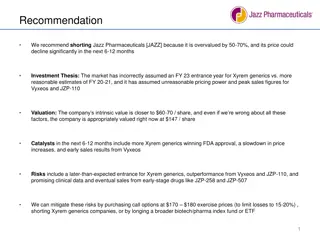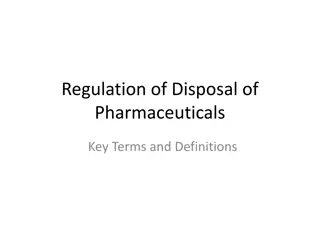Understanding Colloids and Their Importance in Pharmaceuticals
Colloids play a vital role in the pharmaceutical industry as heterogeneous biphasic systems with particle sizes ranging from 1nm to 100nm. They are classified based on aggregation and interaction of phases, with examples like aerosols, foams, emulsions, and more. Colloids can be prepared by condensation or dispersion methods and exhibit unique properties such as slow diffusion, colored appearance, and settling upon centrifugation. Brownian motion describes the rapid, random movement of colloidal particles in a dispersion medium.
Download Presentation

Please find below an Image/Link to download the presentation.
The content on the website is provided AS IS for your information and personal use only. It may not be sold, licensed, or shared on other websites without obtaining consent from the author. Download presentation by click this link. If you encounter any issues during the download, it is possible that the publisher has removed the file from their server.
E N D
Presentation Transcript
Colloids and their role in Pharmaceutical Industry
Colloids A mixture in which very small particles of one substance are distributed evenly throughout another substance.
History This term was first used in 1862 to distinguish colloids from crystalloids. Colloids have been studied by scientists since the early 1800 s. to
Introduction The word colloid was derived from the Greek, kolla for glue. Colloid is short synonym for colloidal system. The heterogeneous biphasic system. Size of colloidal particle ranges from 1nm to100nm.
Classification There are two criteria's for classification of colloids. 1. Based on the state of Aggregation ofphase 2. Based on the interaction of phase
Aggregation of phase Based on the state of aggregation of dispersed phase and dispersion medium, colloidal solutions are classified into 1.Aerosol (liquid or solid in gas) 2. Foam (gas in liquid) 3. Emulsion (liquid in liquid) 4. Sol (solid in liquid) 5. Gel (liquid in solid)
Interaction of phase On the basis of affinity between two phases, colloidal solutions are classified into Lyophobicsols 1. Examples sols of Metals, sulphur 2. Lyophilic sols Examples gums, starch
Preparation Two preparation of colloidal solutions. 1. By Condensation 2. By Dispersion methods are generally used for the
GeneralProperties 1. Phase Heterogeneous 2. Particle size 1nm to 100nm 3. Separation Ultrafiltration 4. Setting Settles on centrifugation 5. Appearance Generally clear 6. Diffusion Diffuse slowly 7. Color Invariably colored Examples Milk, Blood, fog
Kineticproperties Brownian motion Rapid, random, zigzag movement of colloidal particles through dispersion medium. This movement is due to bombardment of colloidal particles by the molecules of dispersion medium.
Opticalproperties Tyndall Effect Light scattering by colloidal particles. Bright cone of scattered light is called Tyndall cone.
Electricalproperties Charges on colloidal particles: Colloidal particles always carry some charge otherwise the colloidal solution would be unstable. It may be positively or negatively charged. Due to acidic and basic groups
Purification The colloidal solutions prepared by any method contain different impurities. They can be separated by 1. Dialysis 2. Ultrafiltration
Role in pharmaceutics Therapy Colloidal system are used as therapeutic agents in different areas. Colloidal medicines are more effective and are easily absorbed in our system. Example ,penicillin and streptomycin.
Eye lotions There are various eye lotions that are prepared by colloidal solutions. Argyrol and protargyrol
Colloidalsulphur It is used as disinfectants. It is a homeopathic remedy used to treat skin conditions such as psoriasis, eczema etc.
Colloidal copper It is used in treatment of cancer. It is used as a remedy for burns, arthritis, parasites, viral and bacterial infections.
Colloidal Gold It is diagnostic agent for paresis. It is used as mineral supplement to augment the body s immune system.
Colloidal silver It is an unrivalled anti-biotic. It destroy all types of virus, bad fungi and bacteria. It promotes healing.
Colloidal electrolytes Increase solubility, stability and taste of compounds Used as additives in drugs E.g. Quaternary Ammonium salts
colloidalSilica Preventsflocculation. Stability to drugs. e.g. silicon dioxide
Natural colloids Plasma protein. Gelatin coating over tablets and granules. For protection.























